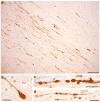Axonal pathology in traumatic brain injury
- PMID: 22285252
- PMCID: PMC3979341
- DOI: 10.1016/j.expneurol.2012.01.013
Axonal pathology in traumatic brain injury
Abstract
Over the past 70years, diffuse axonal injury (DAI) has emerged as one of the most common and important pathological features of traumatic brain injury (TBI). Axons in the white matter appear to be especially vulnerable to injury due to the mechanical loading of the brain during TBI. As such, DAI has been found in all severities of TBI and may represent a key pathologic substrate of mild TBI (concussion). Pathologically, DAI encompasses a spectrum of abnormalities from primary mechanical breaking of the axonal cytoskeleton, to transport interruption, swelling and proteolysis, through secondary physiological changes. Depending on the severity and extent of injury, these changes can manifest acutely as immediate loss of consciousness or confusion and persist as coma and/or cognitive dysfunction. In addition, recent evidence suggests that TBI may induce long-term neurodegenerative processes, such as insidiously progressive axonal pathology. Indeed, axonal degeneration has been found to continue even years after injury in humans, and appears to play a role in the development of Alzheimer's disease-like pathological changes. Here we review the current understanding of DAI as a uniquely mechanical injury, its histopathological identification, and its acute and chronic pathogenesis following TBI.
Keywords: Axon; Axonal pathology; DAI; Diffuse axonal Injury; Head injury; Microtubule; Neurodegeneration; Rotational acceleration; TBI; Traumatic brain injury.
Copyright © 2012 Elsevier Inc. All rights reserved.
Figures


References
-
- Adams JH, Doyle D, Ford I, Gennarelli TA, Graham DI, DR M. Diffuse axonal injury in head injury: definition, diagnosis and grading. Histopathology. 1989;15:49–59. - PubMed
-
- Adams JH, D D, Ford I, Gennarelli TA, Graham DI, McLellan DR. Diffuse axonal injury in head injury: definition, diagnosis and grading. Histopathology. 1989;15:49–59. - PubMed
-
- Adams JH, Doyle D, Ford I, Gennarelli TA, Graham DI, McClellan DR. Diffuse axonal injury in head injury: definition, diagnosis, and grading. Histopathol. 1989;15:49–59. - PubMed
-
- Adams JH, Doyle D, Ford I, Gennarelli TA, Graham DI, McLellan DR. Diffuse axonal injury in head injury: definition, diagnosis and grading. Histopathology. 1989;15:49–59. - PubMed
-
- Adams JH, Doyle D, Graham DI, et al. Diffuse axonal injury in head injuries caused by a fall. Lancet. 1984;2:1420–1422. - PubMed
Publication types
MeSH terms
Grants and funding
LinkOut - more resources
Full Text Sources
Other Literature Sources
Medical
Research Materials
Miscellaneous

